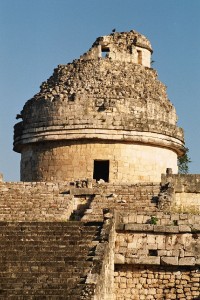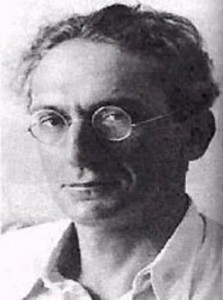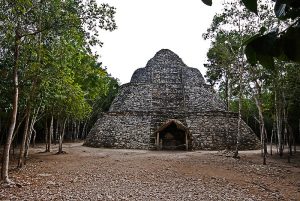Venus, Mystery Planet of Mesoamerica
 The civilizations of Mesoamerica abounded in mysteries. What caused their fixation on Venus? What led them to develop their intricate, highly precise calendars? What can explain the little pecked-cross circles embedded in the landscape? Why were these peoples so keenly bent on human sacrifice? What were the Aztecs referring to when they said that this was the age of the Fifth Sun?
The civilizations of Mesoamerica abounded in mysteries. What caused their fixation on Venus? What led them to develop their intricate, highly precise calendars? What can explain the little pecked-cross circles embedded in the landscape? Why were these peoples so keenly bent on human sacrifice? What were the Aztecs referring to when they said that this was the age of the Fifth Sun?
We have a skeleton key that can unlock these old secrets. But to understand this key and use it appropriately, we must first come to terms with arguably the most remarkable ongoing case of scientific rejectionism.
The Venus Theory
The biggest controversy in planetary science since Copernicus and Galileo revolved around the question of whether Venus had once been a comet.
Psychoanalyst Immanuel Velikovsky’s 1950 book Worlds in Collision touched off a bitter debate that went on until his death in 1979 and, in a subdued  but increasingly fruitful way, continues to this day.
but increasingly fruitful way, continues to this day.
Velikovsky interpreted the Greek myth that Athena had sprung fully armed from the head of Zeus to mean that the planet Jupiter had ejected Venus as a comet that then entered the inner solar system. Every 52 years Venus approached Earth, Velikovsky argued; and their encounters caused tsunamis, earthquakes, and other catastrophes recorded in ancient texts. Finally, after many interactions with Earth and some with Mars, Venus circularized its orbit and gradually lost its cometary tail.
Not surprisingly, many scientists found this hard to believe. They pointed out numerous mistakes by Velikovsky. They considered the notion that Venus had exploded out of Jupiter especially bizarre and contrary to the laws of physics. In turn, this led many to consider Velikovsky a kook and to dismiss his theory out of hand.
With the passing of time, however, new evidence and reinterpretation have emerged. Instead of the unpersuasive argument that Venus burst forth from Jupiter, we now see that another myth that Velikovsky failed to interpret offers a satisfying explanation.
Zeus was said to have turned Metis, after impregnating her, into a fly who then zipped into his mouth. Metis gave birth to Athena inside of him, and then Athena emerged from his head. In effect, a Greek observer had spotted proto-Venus as Jupiter’s immense gravity pulled it from the outer solar system and tidal friction heated it up to incandescence, and the Greeks called this Metis.
Once we reinterpret the origin of Venus in this way, then the remarkable astronomical, geological, archaeological, historical, calendrical, iconographic, and linguistic evidence that Velikovsky amassed in favor of the Venus theory comes to bear. And now a steady stream of telling new evidence from Greece, the Ancient Near East, Great Britain, and China adds to it, as do new interpretations. Thus it seems fair to say that Velikovsky’s Venus theory, with one important correction, has triumphed, though many peripheral issues remain open to debate.1
Velikovsky referred repeatedly to Mesoamerican evidence to buttress his arguments. But Worlds in Collision was never translated into Spanish, while the controversy appears to have had little resonance in Mexico or Central America, and Velikovsky’s name has practically vanished from the scholarly literature. Also, new evidence and interpretation regarding ancient Mesoamerica have appeared since Velikovsky’s time that need to be examined with reference to the Venus theory.
Correctly applying a revised, enhanced version of Velikovsky’s Venus theory can shed light on fundamental questions of Mesoamerican history and offer us a rich agenda for further research.
New Findings and Reinterpretation
Much research has been done since Velikovsky’s death in 1979, and it has become increasingly fruitful as new researchers unburdened with past controversy have appeared on the scene. By now they have gathered an array of telling new evidence; equally important, as we have seen, they have corrected a key misinterpretation by Velikovsky and newly interpreted a crucial myth that he had overlooked. Velikovsky was a wide-ranging pioneer, so inevitably he made a pioneer’s mistakes and can be forgiven for them. What he got right was much more important than what he got wrong.
The new findings include, first, evidence that the approaches of Venus began shortly before 2500 BC, not 1500 BC, as Velikovsky had argued. In the Mesoamerican context, that means that most of the first 1000 years of Venus’ dramatic interactions with Earth took place before the rise of the Olmecs, the first civilization in the region. Thus both the scanty pre-Olmec evidence, e.g., in early mounds, and Olmec culture as the first articulated repository of Mesoamerican knowledge gain special relevance because these sources were from eyewitnesses of the arrival of Venus and the first catastrophes.
Second, Herodotus wrote that Egyptian priests had told him that four times since Egypt became a kingdom “the Sun rose contrary to his wont; twice he rose where he now sets, and twice he set where he now rises.” Velikovsky used this to propose a second theory, that Earth had inverted four times during close approaches of Venus. Now we have very approximate estimated dates for the four inversions: 2200, 1628, 1210, and 820 BC,2 and we understand the mechanism of inversion.3 Presumably, these inversions caused the overwhelming catastrophes associated with the ends of suns or world ages in Mayan and Aztec accounts. Subinversional events also occurred on not-so-close encounters between Venus and Earth on a 52-year cycle. They may have dislodged Earth’s body by several degrees and could explain otherwise odd orientations of buildings and cities.
Possession of an approximate chronology of inversions permits us to ascertain when the Sun was rising in the west, in parallel with information from China and Egypt. That can help us detect alignments and references to the western-rising Sun in Mesoamerican literature and iconography. However, the fact that the last inversion occurred around 820 BC also tells us that the great preponderance of astronomical evidence we possess—from Teotihuacan, Toltecs, Mayans, and Aztecs—is not contemporaneous with the catastrophes. Thus it was vulnerable to erosion and reshaping by cultural amnesia. Still, in a remarkable irony, Mesoamerican civilization faithfully and tenaciously retained the most highly detailed records of the astronomy and practices associated with Venus and the catastrophes of any civilization.
Third, we now know that in ancient times Venus was an ovoid, and we know why: upon passage of Jupiter, it turned molten from tidal heating and was practically pulled in two by the giant planet’s gravity field. This also explains the anomalous slow (but rapidly reversing) retrograde rotation of Venus. Certain depictions of Venus in glyphs contain ovals, and we can hunt for oval mounds. The Pyramid of the Magician in Uxmal has an oval base reminiscent of several oval temples in Mesopotamia. Mindful of the power of cultural amnesia, we can ask whether circular patterns in buildings associated with Venus4 or in the widespread small pecked-cross circles were originally oval. 5 (The photo shows the Oval Temple of Copán, Honduras. (By Dlogic (Own work) [CC BY 3.0], via Wikimedia Commons) So, too, an oval can be reshaped into a rectangle, so we might hunt beneath rectangles to find evidence of this, particularly in mounds.
5 (The photo shows the Oval Temple of Copán, Honduras. (By Dlogic (Own work) [CC BY 3.0], via Wikimedia Commons) So, too, an oval can be reshaped into a rectangle, so we might hunt beneath rectangles to find evidence of this, particularly in mounds.
Fourth, we have a much better understanding of the role of effigy monuments in the response of people worldwide to the awesome and fearsome comet Venus. They felt a powerful urge to propitiate the god, and they did so via effigies and sacrifices. The Great Serpent Mound in Ohio (with an oval in the serpent’s mouth), the elongated, red-painted Great Sphinx of Giza (with its temple containing two sanctuaries—evidently for the Morning Star and Evening Star, as in the Aztec double pyramids), and the great raptor bird formed by stones around a central oval at Karahunj, Armenia show how peoples sought to tell the terrifying comet god that they were his/her people, and he/she should spare them. The intricate patterns of stones at Stonehenge contain a Venus effigy and an oval. The surmise that the great Olmec mound in San Lorenzo was a giant bird effigy6 neatly fits into this pattern, and other such effigies may still exist in Mesoamerica. In pre-Inca Peru, U-shaped mounds and plazas were constructed to honor Comet Venus, of which the twin tails appeared an a U-shape.
The Original Theory Explains Much
In its original version, Velikovsky’s Venus theory nicely explains many Mesoamerican phenomena. Comet Venus as Morning Star was Quetzalcoatl, the plumed serpent. Venus was also called the Red Star because interplanetary and atmospheric dust stirred up by the catastrophes made it look red. The mythical battles of Quetzalcoatl with Tezcatlipoca were accounts of the interaction of Venus and Mars, as in the Iliad and in Chinese myths. Over time Venus lost its cometary tail in encounters with Earth, Mars, and, when its orbit was still highly elliptical, perhaps even with Jupiter. As its orbit circularized from repeated tugs of Earth’s and Mars’ gravity and other factors, Venus became the benign Morning Star and Evening Star. This explains why its original identity as a war god demanding bloody sacrifices was joined by a very different identity of the Rain God Chac/Tlaloc, in keeping with its appearance coinciding with the rainy season.
Velikovsky also correctly interpreted the Mayan and Aztec accounts of the ends of four worlds to fit the four inversions. We can now add that the inversions suggested that the Sun itself could be a source of danger (that it would collapse) and thus required human hearts and blood. This would explain why ritual human sacrifices shifted from being offered to the ever-more-benign Venus, whose movements were becoming more predictable and less threatening even as it lost its tail and became spheroidal, to being directed to the Sun in an effort to ensure that the Fifth Sun, our present era in Aztec lore, would not also end in catastrophe.
We already know that the Aztecs misnamed the Pyramid of the Sun and presumably also the Pyramid of the Moon at Teotihuacan. They were both monuments to various aspects of Tlaloc/Venus. Thus, including the Temple of Quetzalcoatl (the Morning Star), Teotihuacan was a wholly Venus site.
We can also interpret the ball game of Mesoamerica as a contest to bet on/influence the possibility of a new inversion of the Sun that would shift its rising from East to West, or vice versa. Of course, many variants of the ball game existed, and there were many purposes for which they were played.
Velikovsky pointed out that the observational “mistakes” in Mesoamerican and other ancient records of Venus were actually accurate. Venus had an irregular and hard-to-track orbit that deviated from the present-day pattern.7 In turn, this explains why the Mesoamericans were so eager to monitor its orbit: when Venus disappeared, especially at Inferior Conjunction, it could be approaching Earth. Hence the malign character of the Evening Star, which was the one that might approach; the need to follow it carefully at its greatest elongation; the sacred significance of the number 8 as the normal length of the Inferior Conjunction; and the fear attending the date of the hoped-for heliacal rising of the Morning Sun as well as the joy when it rose as hoped.
Conclusions
Four conclusions suggest themselves.
First, Worlds in Collision should be translated into Spanish.
Second, students of Mesoamerican archaeoastronomy need to familiarize themselves with Worlds in Collision and the new findings and reinterpretations regarding the Venus theory.
Third, we need to reexamine many phenomena in Mesoamerican history and culture in the light of the revised and enhanced Venus theory. For instance, it offers opportunities for better defining and explaining orientations, yet at the same time it complicates the issue because one must ask whether the era in which the orientation was established was one of a western-rising Sun, or whether the orientation followed the practice of such an era even after it ended. Similarly, dislocations of Earth’s body during sub-inversions could affect orientations in a hard-to-ascertain manner. We also need to investigate the important role of Mars in the Venus theory.
Fourth, we need to exploit newly interpreted, rich Mesoamerican sources on Venus and archaeoastronomy to contribute to the correct interpretation of archaeoastronomy sites worldwide.
Even though he made plenty of pioneer’s mistakes, Immanuel Velikovsky was an insightful scientist. His theories of Venus and of the Reversing Earth constitute outstanding contributions to science and history. Scientific rejectionism of Velikovsky has led to many errors in science and history, and these need correction.
In general, resolving cases of scientific rejectionism can lead to exciting opportunities for new findings.
*****
Kenneth J. Dillon is a historical and scientific researcher who writes on science, medicine, and history. See the biosketch at About Us. For further detective work on ancient and modern history, see his The Knowable Past (Washington, D.C.: Scientia Press, 2018).
